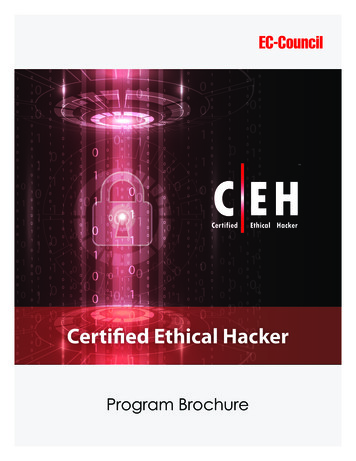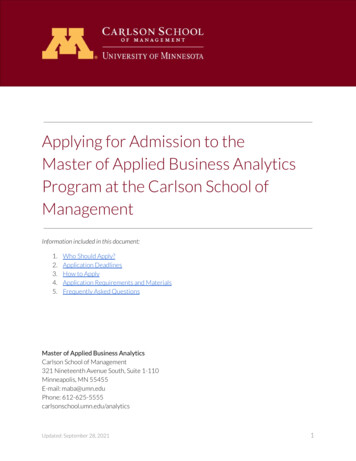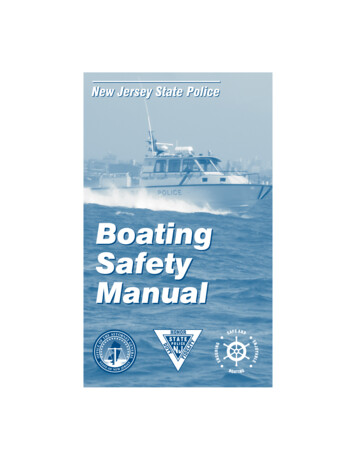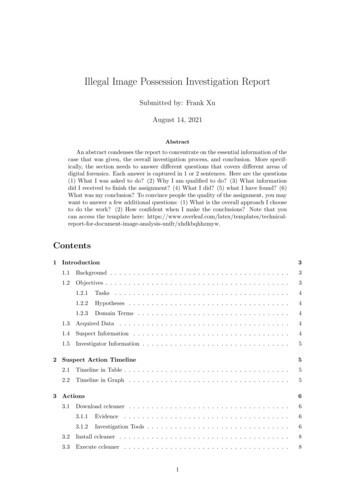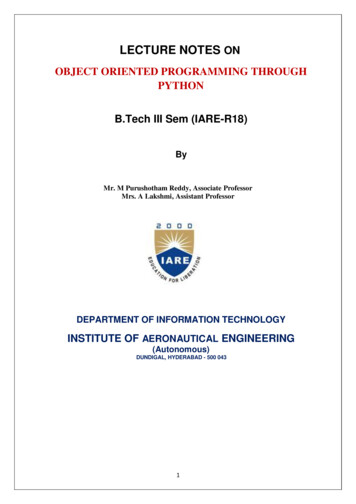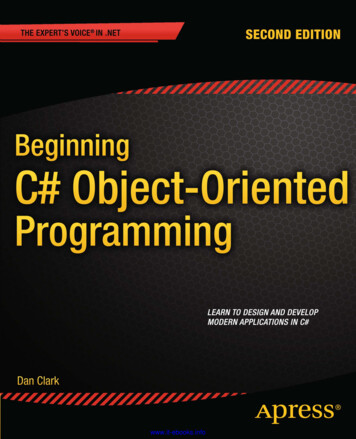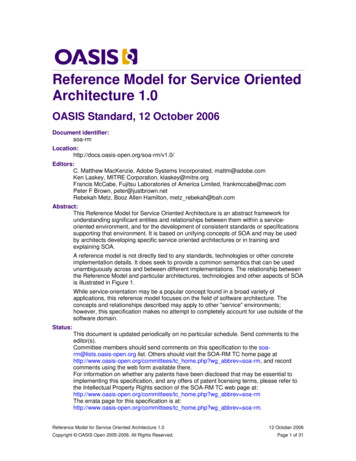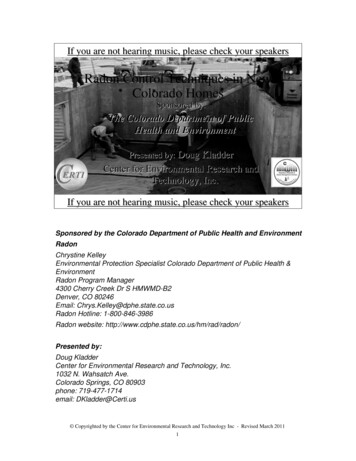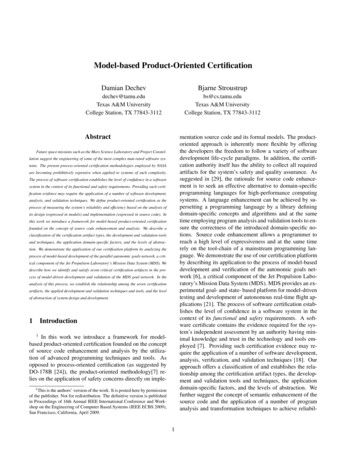
Transcription
Model-based Product-Oriented CertificationDamian DechevBjarne Stroustrupdechev@tamu.eduTexas A&M UniversityCollege Station, TX 77843-3112bs@cs.tamu.eduTexas A&M UniversityCollege Station, TX 77843-3112Abstractmentation source code and its formal models. The productoriented approach is inherently more flexible by offeringthe developers the freedom to follow a variety of softwaredevelopment life-cycle paradigms. In addition, the certification authority itself has the ability to collect all requiredartifacts for the system’s safety and quality assurance. Assuggested in [29], the rationale for source code enhancement is to seek an effective alternative to domain-specificprogramming languages for high-performance computingsystems. A language enhancement can be achieved by supersetting a programming language by a library definingdomain-specific concepts and algorithms and at the sametime employing program analysis and validation tools to ensure the correctness of the introduced domain-specific notions. Source code enhancement allows a programmer toreach a high level of expressiveness and at the same timerely on the tool-chain of a mainstream programming language. We demonstrate the use of our certification platformby describing its application to the process of model-baseddevelopment and verification of the autonomic goals network [6], a critical component of the Jet Propulsion Laboratory’s Mission Data System (MDS). MDS provides an experimental goal- and state- based platform for model-driventesting and development of autonomous real-time flight applications [21]. The process of software certification establishes the level of confidence in a software system in thecontext of its functional and safety requirements. A software certificate contains the evidence required for the system’s independent assessment by an authority having minimal knowledge and trust in the technology and tools employed [7]. Providing such certification evidence may require the application of a number of software development,analysis, verification, and validation techniques [18]. Ourapproach offers a classification of and establishes the relationship among the certification artifact types, the development and validation tools and techniques, the applicationdomain-specific factors, and the levels of abstraction. Wefurther suggest the concept of semantic enhancement of thesource code and the application of a number of programanalysis and transformation techniques to achieve reliabil-Future space missions such as the Mars Science Laboratory and Project Constellation suggest the engineering of some of the most complex man-rated software systems. The present process-oriented certification methodologies employed by NASAare becoming prohibitively expensive when applied to systems of such complexity.The process of software certification establishes the level of confidence in a softwaresystem in the context of its functional and safety requirements. Providing such certification evidence may require the application of a number of software development,analysis, and validation techniques. We define product-oriented certification as theprocess of measuring the system’s reliability and efficiency based on the analysis ofits design (expressed in models) and implementation (expressed in source code). Inthis work we introduce a framework for model-based product-oriented certificationfounded on the concept of source code enhancement and analysis. We describe aclassification of the certification artifact types, the development and validation toolsand techniques, the application domain-specific factors, and the levels of abstraction. We demonstrate the application of our certification platform by analyzing theprocess of model-based development of the parallel autonomic goals network, a critical component of the Jet Propulsion Laboratory’s Mission Data System (MDS). Wedescribe how we identify and satisfy seven critical certification artifacts in the process of model-driven development and validation of the MDS goal network. In theanalysis of this process, we establish the relationship among the seven certificationartifacts, the applied development and validation techniques and tools, and the levelof abstraction of system design and development.1Introduction1In this work we introduce a framework for modelbased product-oriented certification founded on the conceptof source code enhancement and analysis by the utilization of advanced programming techniques and tools. Asopposed to process-oriented certification (as suggested byDO-178B [24]), the product-oriented methodology[7] relies on the application of safety concerns directly on imple1 This is the authors’ version of the work. It is posted here by permissionof the publisher. Not for redistribution. The definitive version is publishedin Proceedings of 16th Annual IEEE International Conference and Workshop on the Engineering of Computer Based Systems (IEEE ECBS 2009),San Francisco, California, April 2009.1
ity and efficiency in the system implementation. Our casestudy in Section 4 illustrates the practical application of ourapproach. We describe how we identify and satisfy sevencritical certification artifacts in the process of model-drivendevelopment and validation of the MDS goal network. Inthe analysis of this process, we establish the relationshipamong the seven certification artifacts, the applied development and validation techniques and tools, and the level ofabstraction of system design and development.2Background and Previous WorkFuture space exploration projects such as the Mars Science Laboratory (MSL) [31] and Project Constellation [27]suggest the engineering of some of the most complex manrated software systems. As stated in the Columbia AccidentInvestigation Board Report [3], the inability to thoroughlyapply the required certification protocols had been determined to be a contributing factor to the loss of STS-107,Space Shuttle Columbia. Schumann and Visser’s discussion in [25] suggests that the current process-oriented certification methodologies are prohibitively expensive for systems of such complexity. A detailed analysis by Lowry [18]indicates that at the present moment the certification costof mission-critical space software exceeds its developmentcost. The challenges of certifying and re-certifying avionics software has led NASA to initiate a number of advancedexperimental software development and testing platforms,such as the Mission Data System (MDS) [21], as well asa number of program synthesis, modeling, analysis, andverification platforms, such as The JavaPathFinder [2], theCLARAty project [30], Project Golden Gate [10], The NewMillenium Architecture Prototype (NewMAAP) [9].2.1Complex Systems AnalysisIn [20] Perrow studies the risk factors in the modern hightechnology systems. His work identifies two significantsources of complexity in modern systems: interactions andcoupling. The systems most prone to accidents are thosewith complex interactions and tight coupling. With the increase of the size of a system, the number of functions it hasto serve, as well as its interdependence with other systems,its interactions become more incomprehensible to humanand machine analysis and this can cause unexpected andanomalous behavior. Tight coupling [20] is defined by thepresence of time-dependent processes, strict resource constraints, and little or no possible variance in the executionsequence. Perrow classifies space missions in the riskiestcategory since both hazard factors are present.2.2Parallelism and ComplexityIn a parallel application, there are a number of challengesthat are not known in sequential programming: most importantly to correctly manipulate data where multiple threadsaccess it. The most commonly applied technique for controlling the interactions of the concurrent processes is theapplication of mutual exclusion locks. A mutual exclusion lock guarantees thread-safety of a concurrent objectby blocking all contending threads except the one holdingthe lock. This can seriously affect the performance of thesystem and diminish its parallelism. For the majority ofapplications, the problem with locks is one of difficulty ofproviding correctness more than one of performance. Theapplication of mutually exclusive locks poses significantsafety hazards and incurs high complexity in the testing andvalidation of mission-critical software. Mutual exclusionlocks can be optimized in some scenarios by utilizing finegrained locks [14] or context-switching. Often due to theresource limitations of flight-qualified hardware, optimizedlock mechanisms are not a desirable alternative [18]. Evenfor efficient locks, the interdependence of processes impliedby the use of locks, introduces the dangers of deadlock, livelock, and priority inversion. The incorrect application oflocks is hard to determine with the traditional testing procedures and a program can be deployed and used for a longperiod of time before the flaws cause anomalous behavior.As discussed by Lowry [18], in July 1997 The MarsPathfinder mission experienced a number of anomalous system resets that caused an operational delay and loss of scientific data. The follow-up study identified the presence ofa priority inversion problem caused by the low-priority meteorological process blocking the high-priority bus management process. The investigation furthermore revealed that itwould have been impossible to detect the problem with theblack box testing applied at the time to derive the certification artifacts. A more appropriate priority inversion inheritance algorithm had been ignored due to its frequency ofexecution, the real-time requirements imposed, and its highcost incurred on the slower flight-qualified computer hardware. The efficient and reliable control of the subtle interactions in the concurrent applications of the modern aerospaceautonomous systems is of critical importance to the overall system’s safety and correct operation. Despite the challenges in debugging and verification of the system’s concurrent components, the existing certification process [24]does not provide guidelines at the level of detail reachingthe development, application, and testing of concurrent programs. This is largely due to the process-oriented nature ofthe current certification protocols and the complexity andhigh level of specialization of the aerospace autonomousembedded applications. In the near future, NASA plans todeploy a number of diverse vehicles, habitats, and support-
ing facilities for its imminent missions to the Moon, Marsand beyond. According to [21] some of the most significantchallenges for such systems are managing a large number oftightly-coupled components, performing operations in uncertain remote environments, ability to respond and recoverfrom anomalies, guaranteeing the system’s correctness andreliability, and the effective communication across the system’s components.3Principles of Model-basedProduct-Oriented CertificationWe define product-oriented certification as the processof establishing the system’s reliability and efficiency basedon the analysis of its design (expressed in models) and implementation (expressed in source code). In this section wedescribe a classification of the certification artifact types,the development and validation tools and techniques, theapplication domain-specific factors, and the levels of abstraction. In our framework a certification artifact type canbe one of the following:(1) Invariant (η): a critical property or assumption that is constant (does not change throughout the transformation of program/system states) and must hold at all time to ensure the validity and correct operation of a program or a system.Examplea.: the values stored in a given shared vector must be wordsized pointers. Example b.: a graph of temporal constraints[6] must contain no cycles.(2) Guarantee (γ): a goal or condition that needs to be satisfied.Unlike invariants, goals can be defined differently at differentmoments of the lifecycle of a system. Example: an event Eamust precede an event Eb in the autonomic operation of arobot.(3) Constraint (κ): a physical and resource constraint that needto be observed. Example: the physical memory available tostore a graph of autonomic goals is 7168KB.(4) Performance artifact ( ): an artifact describing the quality ofoperation and degree of optimization. Example: Complexityand space efficiency of a particular propagation scheme in anetwork of temporal constraints.(5) Comprehension artifact (σ): an artifact measuring the humanunderstanding of the interactions, coupling, and behavior ofa system. Example: a list of all concurrent interleavings in agoal network leading to a state of inconsistency.(6) Re-certification and maintenance artifact (µ): an artifactdemonstrating the ability to re-establish the validity of thesystem upon its evolution and re-use. Example: an automatedprogram analysis tool that checks for the separation of dataand algorithms and thus can demonstrate the validity of thegraph implementation upon the replacement of the constraintpropagation algorithm.3.1DevelopmentSatisfying the certification artifacts in a software systemrequires the application of a combination of software development, modeling, formal verification, and analysis techniques and tools. Expressing as well as checking the certification requirements is enabled and directly dependent onthe following software development dimensions:(1) Model of Computation ( M C ): the computing architecturedefined by the hardware and the operating system. It definesthe sequential or parallel memory model as well as the available basic machine-level instructions and atomic primitives.Example: an embedded multi-core platform with eight processing cores supporting only single-word atomic primitives,such as the single-word Compare-And-Swap (CAS).(2) Programming Language ( P L ): programming constructs, libraries, and techniques available. Example: The availabilityof a nonblocking vector [5] that can allow safe and lock-freeaccess to shared data (and thus eliminate the hazards of deadlock, livelock, and priority inversion).(3) Modeling Tools ( M T ): expressing design notions, automated code generation, and formal verification. Example: theapplication of the SPIN model checker [13] to exhaustivelysearch all concurrent interleavings.(4) Analysis Techniques ( AT ): program static and dynamicanalysis. Example: the application of static analysis utilizinga high-level program representation to guarantee high performance in parallel systems [29].(5) Software Architecture ( SA ): defines the most significant design notions such as system states, system goals, and modes ofcommunication. Example: The Mission Data System definesa unified model-driven architecture for testing and development of autonomous flight software based on the notions ofsystem goals and states.3.2Application DomainsThe application-domain factors have a direct impact indefining the certification requirements and the developmentprocess. We identify the following significant applicationspecific properties for mission critical software:(1) Real-time (Rt): the system must achieve a goal or providea response in a time-constrained manner. Example: The realtime operation of a robot demands a system guarantee that themeteorological process must complete prior to the initiationof communication with mission control.(2) Safety-critical (Sc): establishes that a failure would lead to acatastrophic or hazardous consequences to the entire system.The DO-178B offers a hazards analysis process to assess therisk level upon a module or sub-system failure. Example: ifthe autonomous obstacle avoidance scheme fails, the rover
might crash. Thus, the system invariants and guarantees assuring the correct operation of the system are safety-critical.(3) Embedded (Em): since the system is designed and optimizedaccording to a set of pre-defined goals, its software must often control the hardware, consider strict resource constraints,and handle failures and events that may occur in the physicalworld. Example: the embedded nature and limited memoryavailability of the rover places the constraint that a goal network should not exceed 7168KB of memory space.(4) Autonomous (Au): the system must achieve a set of goalswith little or no human interaction, meanwhile possibly responding to the conditions and events in its environment. Example: the autonomy of the meteorological and bus management processes requires the invariant that the system is freeof the hazards of priority inversion.3.3(6) Framework (Ξ): conditions related to the principle organization and design of the software development. Example:The Mission Data System defines the notions of states andgoals. Their definition and requirements are described (independently from the implementation of a particular mission) ina number of MDS framework papers such as [21].As emphasized by Stroustrup in [28], the concept ofhigher-level systems programming is of significant importance to systems of high complexity and size. Higherlevel systems programming implies that while low-level efficiency is important, the emphasis is placed towards the design, maintenance, and validation of the larger system. Withrespect to the system implementation, it is the programminglanguage facilities for data abstraction and representationof domain-specific concerns that directly address this issue.As defined by Stroustrup [28]:Levels of AbstractionWe classify the system’s safety concerns according totheir rank in the abstraction hierarchy:(1) Physical and Hardware (Φ): related to constraints in thehardware resources, organization, and architecture and theconditions in the physical environment. Example: the lackof complex atomic primitives on the flight-qualified hardware requires all nonblocking code to rely on the single-wordCompare-And-Swap (CAS) atomic primitive. This demandsthe specification of an invariant that the system must eliminate the possibility of occurrence of the ABA problem [5].(2) Algorithms and Procedures (Θ): invariants of a particularcomputational routine or algorithm. Example: the complexity of Floyd-Warshall’s all-pairs-shortest-path algorithm [4] isO(N 3 ). Due to the frequent execution of the constraint propagation scheme in a goal network the direct application of thealgorithm can be prohibitively expensive. To meet the performance requirements a propagation scheme should executewith complexity of at most O(N 2 ).(3) Libraries (Λ): domain-specific concerns on a set of algorithmsthat are grouped in a standard or custom language extension.Example: a library of CAS-based nonblocking algorithmsmust guarantee its ABA-freedom.(4) Modules and Sub-Systems (Ψ): guarantees and quality of service provided by the individual components and sub-systems.Example: The rover’s module performing atmospheric experiments must coordinate its execution with the bus management and the communication systems. Such a coordinationmight lead to a number of safety-critical invariants and guarantees (such as no priority inversion).(5) System (Ω): goals critical for the successful completion ofthe mission. Example: the rover’s goal is to autonomouslynavigate the surface of Mars, perform scientific explorationof the planet’s atmosphere and geology, and communicate results back to mission control. Meeting these goals impacts theguarantees defined by all of the robot’s sub-systems.A programming language serves two related purposes: it provides a vehicle for the programmer to specify actions to be executed and a set of concepts for the programmer to use whenthinking about what can be done. The first aspect ideally requires a language that is ’close to the machine’, so that allimportant aspects of a machine are handled simply and efficiently in a way that is reasonably obvious to the programmer.The C language was primarily designed with this in mind. Thesecond aspect ideally requires a language that is ’close to theproblem to be solved’, so that the concept of a solution can beexpressed directly and concisely. The facilities added to C tocreate C were primarily designed with this in mind.The application of C in a framework for complex, autonomous, and embedded flight software, such as the Mission Data System, further illustrates and emphasized thesignificance of the ability of C to excel in providing both,instructions ’close to the machine’ and facilities that are’close to the problem to be solved’. Language facilitiesallowing the definition of high-level design concepts anddomain-specific concern are often provided by languagelibraries. Such libraries enhance the language semanticmodel by defining notions and guarantees that belong to theproblem domain.Modeling and formal verification tools such as SPIN[13], Alloy Analyzer [15], and Eclipse [26] are used toexpress and validate high-level domain-specific and designconcerns. The challenges associated with the application ofmodeling and formal verification tools in the developmentprocess are:(1) Bridging the implementation source and the software models.(a) from implementation to models: as an abstraction andsimplification of the software implementation, a modelrepresents an aspect of the software solution based ona number of assumptions and rules. Defining these assumptions as well as the verification invariants, and es-
tablishing whether the model is trustworthy with respectto the source are some of the most challenging tasks.(b) from models to implementation: the application of program synthesis techniques such as AutoFilter [8] havebeen applied successfully in a number or flight applications. However, the certification of the produced software is challenged by the strict FAA requirement of having the program synthesis meet the same certification requirements as the produced flight software.(2) Limited state space and heavy computational complexity: despite the advanced state space reduction techniques in manymodern formal verification tools, the main limitations for theirapplicability arise from the heavy computational complexity imposed and the state space explosion problem. Programsimplification and abstract interpretation techniques are oftennecessary to reduce the explored state space. However, according to the FAA certification standards, it is required toestablish the preservation of the program semantics upon theapplication of any program transformation and abstract interpretation techniques.(3) Project Scheduling: the application of formal logic can oftenbe as demanding to the software developers as the engineeringof the system implementation itself.The semantic enhancement of the implementation can allow for the direct validation of some software invariants andguarantees and thus reduce the state space and the computational complexity required in the process of formal verification. In addition, the increased expressiveness and abstraction level of the implementation source can ease themanual or automated transition to and from the softwaremodels. Stroustrup and Dos Reis [29] present the notion ofSemantically Enhanced Library Languages(SELLs). As defined by the authors, a SELL is a domain-specific languagederived from a general-purpose programming language byextending it with libraries defining the concepts and functionalities of the problem domain and then applying an analysis tool to guarantee the higher-level semantic invariants.The main advantages of defining and applying a SELL arefounded in the availability of the maintenance, training, andtool chain of the general-purpose language that had servedas its base. At the same time, a SELL’s main purpose is todeliver a special-purpose language tailored to the ideals andconcepts of a specific application domain. The notion ofSELL is fundamental for the application of our model-basedproduct-oriented framework for software certification.The following section presents a case study describingthe details of how we extend the semantics of ISO C with the libraries defining Temporal Constraint Networksand Shared Containers with Nonblocking Synchronization.Furthermore, we demonstrate how the applied programming and modeling techniques, formal verification, program transformation, and static analysis (in the process ofvalidation and automatic parallelization of goal networks)relate to our classification framework.4A Case Study: Automatic Parallelization ofGoal Networks in MDSMission Data System (MDS) [21] is the Jet PropulsionLaboratory’s framework for designing and implementingcomplete end-to-end data and control autonomous flightsystems. The framework focuses on the representationof three main software architecture principles (definingthe highest SA level of development in the certificationframework):(1) System control: a state-based control architecture withexplicit representation of controllable state [11](2) Goal-oriented operation: control intent is expressed bydefining a set of goal and a goal network [1](3) Layered data management: an integrated data management and transport protocols [32]In MDS a state variable provides access to the data abstractions representing the physical entities under controlover a continuous period of time, spanning from the distantpast to the distant future. In other words, a state variable isa programming ( P L ) and modeling ( M T ) representationof a set of constraint (κ) certification variables (Sκsv ) expressed in the library level of abstraction (Λ). As explainedby Wagner [32], the implementation’s intent is to define agoal timeline overlapping or coinciding with the state variables timeline. This means that the implementation mustrely on an algorithm (abstraction level Θ) that transformsthe engineers intent together with Sκsv into a set of invariants Sηsv and a set of guarantees Sγsv and establish the validity and consistency of all ηi Sηsv and all γi Sγsvso that the system’s operations corresponds with its Rt, Sc,Em, and Au behavior.Computing the invariants (a set of Sηgi ) necessary forachieving a goal (any γi Sγsv ) might require the lookupof past states as well as the computation of projected future states. MDS employs the concept of goals to represent control intent. Goals are expressed as a set of temporalconstraints (Section 4.1). Each state variable is associatedwith exactly one state estimator whose function is to collect all available data and compute a projection of the statevalue and its expected transitions. Control goals are considered to be those that are meant to control external physicalstates. Knowledge goals are those goals that represent theconstraints on the software system regarding a property of astate variable. Not all states are known at all time. The mosttrivial knowledge goal is the request for a state to be known,thus enabling its estimator. A data state is defined as the information regarding the available state and goal data and its
storage format and location. The MDS framework considers data states an integral part of the control system ratherthan a part of the system under control. There are dedicatedstate variables representing the data states. In addition, datastates can be controlled through the definition of data goals.A data state might store information such as location, formatting, compression, and transport intent and status of thedata. A data state might not be necessary for every statevariable. In a simple control system where no telemetry isnecessary, the state variable implementation might as wellstore the information regarding the variable’s value historyand its extrapolated states.The representation of the data states and the data management in MDS is implemented in the Data ManagementService module [32]. The problem of data management inan embedded control system (often requiring the satisfaction of Em, Rt, Au, and Sc -driven certification requirements at the same time) is one of translating the intent ofremote operations into actions and then safely returning theobserved information. The system should be robust to theextent of overcoming possible communication loss, hardware failures or a system reboot. The resource constraint ofan embedded control systems (its collection of κ variables)dictate that command-oriented control systems typically donot retain information specific to the intent of the observations. In addition, telemetry systems process and transportdata in unlabeled packages where the scientific data is oftenmixed with other data. In this context, Wagner argues that itis of significant importance to address the challenges of providing uniform models for managing the flow of observation and control data. The MDS Data Management ServiceLibrary implements a Catalog for organizing the storage ofphysical observations in terms of storage products. Its functionality is responsible for the remote transport of data products with respect to the behavior of other spacecraft components. According to the current lock-based Catalog design,locks are applied in a complex manner within the inheritance hierarchy that leads to an exponential increase of theverification state space.To achieve higher reliability (expressed as a set of safetyinvariants Sηsaf ety ) and enhance the performance (measured in terms of speed of execution in the exe variable),we consider the application of lock-free synchronization. Asdefined by Herlihy [12], a concurrent object is nonblocking(lock-free) if it guarantees that some process in the systemwill make progress in a finite amount of steps. Nonblocking algorithms do not apply mutually exclusive locks andinstead rely on a set of atomic primitives supported by thehardware architecture. This means that a nonblocking technique represents an algorithmic (Θ) or library (Λ) solutionto an important Sc problem, namely avoidance of the hazards of deadlock, livelock, and priority inversion (expressedas three separate Sc invariants: ηlvlock , ηdelock , and ηpinv )whi
tems. The present process-oriented certification methodologies employed by NASA are becoming prohibitively expensive when applied to systems of such complexity. The process of software certification establishes the level of confidence in a software system in the context of its functional and safety requirements. Providing such certi-

